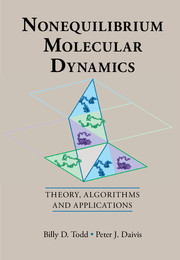Book contents
- Frontmatter
- Contents
- Preface
- 1 Introduction
- 2 Nonequilibrium Thermodynamics and Continuum Mechanics
- 3 Statistical Mechanical Foundations
- 4 Temperature and Thermodynamic Fluxes
- 5 Homogeneous Flows for Atomic Fluids: Theory
- 6 Homogeneous Flows for Atomic Fluids: Applications
- 7 Homogeneous Heat and Mass Transport
- 8 Homogeneous Flows for Molecular Fluids
- 9 Inhomogeneous Flows for Atomic Fluids
- 10 Confined Molecular Fluids
- 11 Generalised Hydrodynamics and Slip
- Bibliography
- Index
7 - Homogeneous Heat and Mass Transport
Published online by Cambridge University Press: 30 March 2017
- Frontmatter
- Contents
- Preface
- 1 Introduction
- 2 Nonequilibrium Thermodynamics and Continuum Mechanics
- 3 Statistical Mechanical Foundations
- 4 Temperature and Thermodynamic Fluxes
- 5 Homogeneous Flows for Atomic Fluids: Theory
- 6 Homogeneous Flows for Atomic Fluids: Applications
- 7 Homogeneous Heat and Mass Transport
- 8 Homogeneous Flows for Molecular Fluids
- 9 Inhomogeneous Flows for Atomic Fluids
- 10 Confined Molecular Fluids
- 11 Generalised Hydrodynamics and Slip
- Bibliography
- Index
Summary
As we have shown in Chapter 2, the transport coefficients appearing in the entropy production of a simple, one component fluid are the bulk and shear viscosities and the thermal conductivity. We have already devoted considerable attention to the shear viscosity, because of its importance as a practical transport coefficient and as a test property for nonequilibrium statistical mechanics. The determination of the thermal conductivity by homogeneous nonequilibrium molecular dynamics techniques is also an interesting and subtle subject, leading to fundamental questions regarding the relationship between the synthetic heat field appearing in nonequilibrium molecular dynamics simulations and the temperature gradient, and the existence of “heat waves”. When binary and multicomponent systems are considered, new transport coefficients associated with diffusion and the Soret and Dufour effects appear, and additional questions regarding the application of linear response theory to equations of motion with phase-space compression arise.
The thermal conductivity can be determined by equilibrium molecular dynamics simulations using the Green–Kubo formula, by homogeneous molecular dynamics methods that introduce a synthetic “heat field”, or by inhomogeneous molecular dynamics methods that examine the heat flow between thermal reservoirs. Here, we will focus on the homogeneous nonequilibrium molecular dynamics methods, because the equilibrium methods have been described in detail elsewhere, and the reservoir methods suffer from the same problems as the “boundary-driven” methods for the determination of the shear viscosity. Reservoir methods work by directly inducing a temperature gradient which must be large due to the poor signal to noise ratio of the molecular dynamics methods. This large temperature gradient also inevitably leads to inhomogeneity of the density. In this case the value of the thermal conductivity obtained from the simulation is the average over a range of temperatures and densities. This is an even greater limitation if we wish to compute the thermal conductivity near the critical point or near a phase transition. Similar considerations apply to the determination of the diffusion coefficient of the binary fluid, and the Soret and Dufour coefficients. Fortunately, in all cases, there exist homogeneous nonequilibrium molecular dynamics algorithms for the determination of these transport coefficients. The equations of motion used in these algorithms generate the desired fluxes in homogeneous systems. In each case, there is a statisticalmechanical proof that the equations of motion lead to the correct determination of the corresponding linear transport coefficient.
- Type
- Chapter
- Information
- Nonequilibrium Molecular DynamicsTheory, Algorithms and Applications, pp. 203 - 228Publisher: Cambridge University PressPrint publication year: 2017



